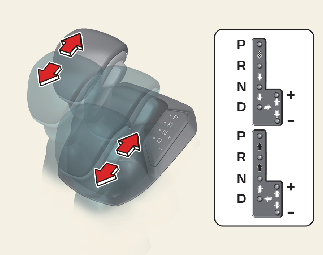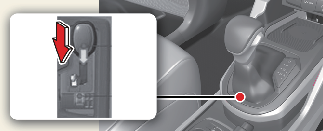Dual clutch transmission (if equipped)
Shift lever type

 Depress the brake pedal and the lock release button when shifting.
Depress the brake pedal and the lock release button when shifting.
 Press the unlock button when shifting.
Press the unlock button when shifting.
 The shift lever can be shifted freely.
The shift lever can be shifted freely.
-
P (Park)
-
R (Reverse)
-
N (Neutral)
-
D (Drive)
Operation
-
Depress the brake pedal and shift the lever.
Manual mode

Operation
-
Push the shift lever from D (Drive) position into the manual gate.
-
Up (+): Push the lever forward once to shift up one gear.
-
Down (-): Pull the lever backwards once to shift down one gear.
-
-
Push the shift lever back into D (Drive) position to return to automatic mode.
Shift lock
Shift lock prevents shifting from P (Park) into R (Reverse) unless the brake pedal is depressed.
Operation
-
Depress and hold the brake pedal.
-
Turn the vehicle to the ON position.
-
Move the shift lever.

If the brake pedal is repeatedly depressed and released with the shift lever in the P (Park), a chattering noise near the shift lever may be heard. This is a normal condition.
Overriding shift lock
If the shift lever cannot be moved from the P (Park) position into R (Reverse) position.

Operation
-
Continue depressing the brake.
-
Turn the vehicle to the OFF position.
-
Make sure the parking brake is applied.
-
Carefully remove the shift knob boot.
-
Insert a tool (e.g. flathead screwdriver) into the access hole and press down on the tool.
-
Move the shift lever.
-
Remove the tool from the shift lock override access hole then install the knob boot.
Have the system checked by a professional workshop. Kia recommends to visit an authorised Kia dealer/service partner.
Parking in N (Neutral) gear
Follow the steps below when the vehicle needs to be pushed whilst parking.
Operation
-
Park your vehicle.
-
Depress the brake pedal.
-
Shift to P (Park) with the vehicle in ON position, or whilst the engine is running.
-
If the parking brake is applied, disengage the parking brake.
-
Whilst pressing the brake pedal, turn the ignition switch to OFF position.
If equipped with smart key, the vehicle can be moved to OFF position only when the transmission in P (Park).
-
Carefully remove the shift knob boot.
-
Insert a tool (e.g. flathead screwdriver) into the access hole and press down on the tool.
-
Move the shift lever to N (Neutral).
-
Remove the tool from the shift lock override access hole then install the knob boot.
Insert a screwdriver into the access hole and press down on the screwdriver.

-
With the exception of parking in neutral gear, always park the vehicle in P (Park) for safety and engage the parking brake.
-
Before parking in N (Neutral), first make sure the parking ground is leveled and flat. Do not park in N (Neutral) on any slopes or gradients. If parked and left in N (Neutral), the vehicle may move and cause serious damage and injury.
When the battery is discharged
Operation
-
Connect the battery cables to the jump-starting terminals inside the engine compartment. For more details, refer to More Details.
-
Release the parking brake when the vehicle is in ON position.
-
Shift to N (Neutral).
Characteristics of Dual clutch transmission
The dual clutch transmission has seven forward speeds and one reverse speed.The individual speeds are selected automatically when the shift lever is in the D (Drive) position.
-
The dual clutch transmission can be thought of as an automatically shifting manual transmission. It gives the driving feel of a manual transmission, yet provides the ease of a fully automatic transmission.
-
When D (Drive) is selected, the transmission will automatically shift through the gears similar to a conventional automatic transmission. Unlike a traditional automatic transmission, the gear shifting can sometimes be felt and heard as the actuators engage the clutches and the gears are selected.
-
The dual clutch transmission incorporates a dry-type dual clutch mechanism, which allows for better acceleration performance and increased fuel efficiency whilst driving. But it differs from a conventional automatic transmission because it does not incorporate a torque converter. Instead, the transition from one gear to the next is managed by clutch slip, especially at lower speeds.
As a result, shifts are sometimes more noticeable, and a light vibration can be felt as the transmission shaft speed is matched with the engine shaft speed. This is a normal condition of the dual clutch transmission.
-
The dry-type clutch transfers torque more directly and provides a direct-drive feeling which may feel different from a conventional automatic transmission. This may be more noticeable when launching the vehicle from a stop or when travelling at low, stop-and-go vehicle speeds.
-
When rapidly accelerating from a lower vehicle speed, the engine rpm may increase dramatically as a result of clutch slip as the dual clutch transmission selects the correct gear. This is a normal condition.
-
When accelerating from a stop on an incline, press the accelerator smoothly and gradually to avoid any shudder feeling or jerkiness.
-
When travelling at a lower vehicle speed, if you release the accelerator pedal quickly, you may feel engine braking before the transmission changes gears. This engine braking feeling is similar to operating a manual transmission at low speed.
-
When driving downhill, you may wish to move the gear shift lever to Manual Shift mode and downshift to a lower gear in order to control your speed without using the brake pedal excessively.
-
When you turn the engine on and off, you may hear clicking sounds as the system goes through a selftest. This is a normal sound for the dual clutch transmission.
-
During the first 1,500 km (1000 miles), you may feel that the vehicle may not be smooth when accelerating at low speed. During this break-in period, the shift quality and performance of your new vehicle is continuously optimized.